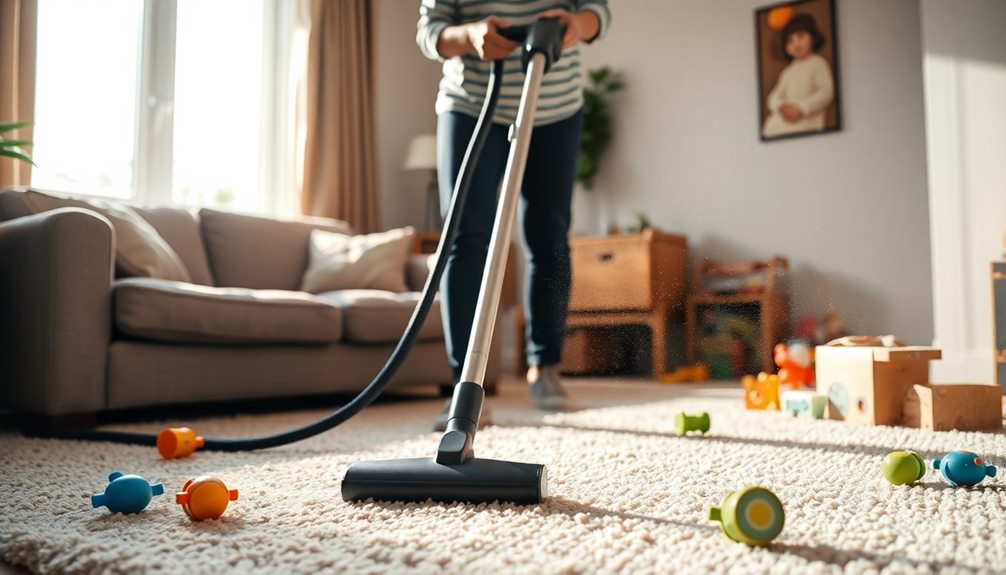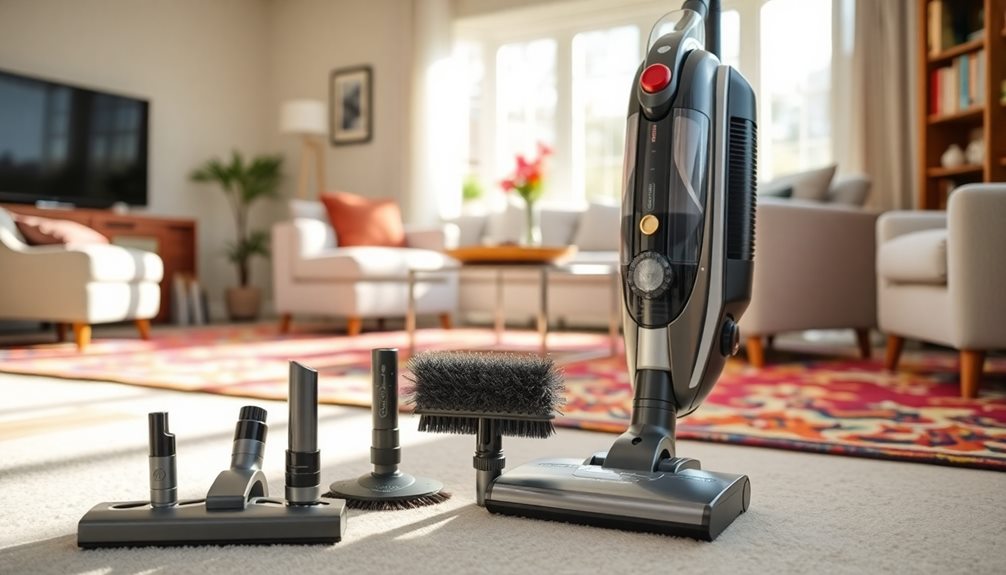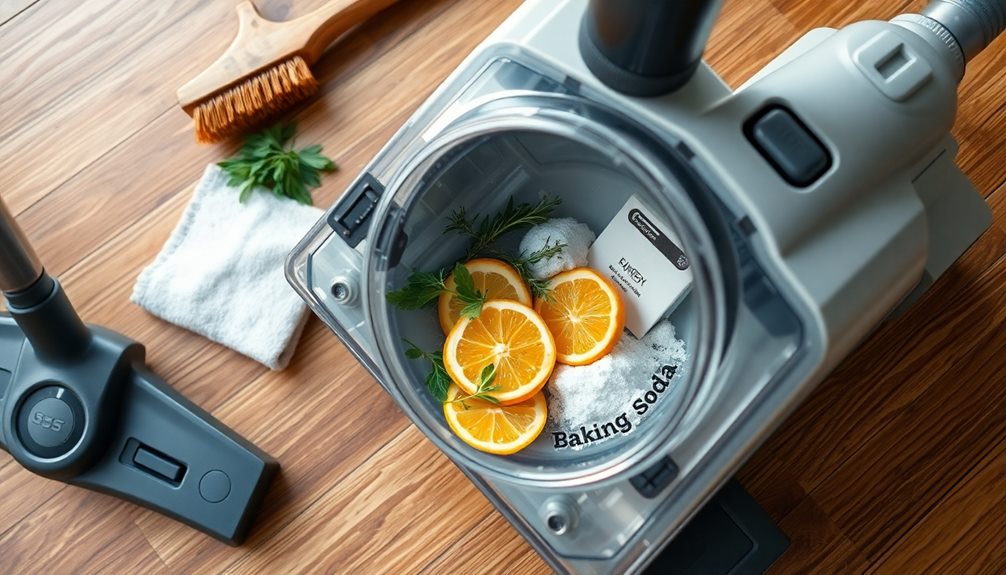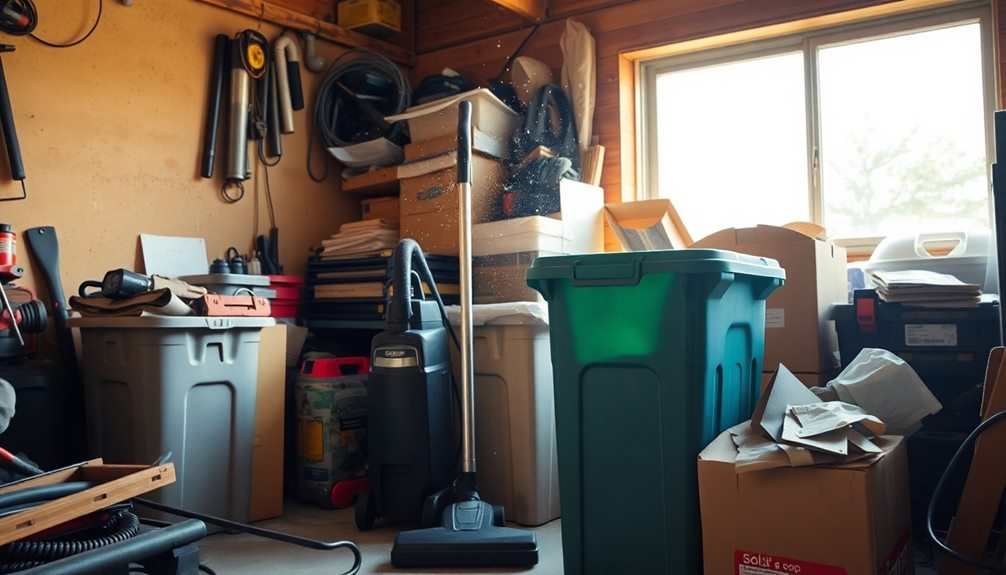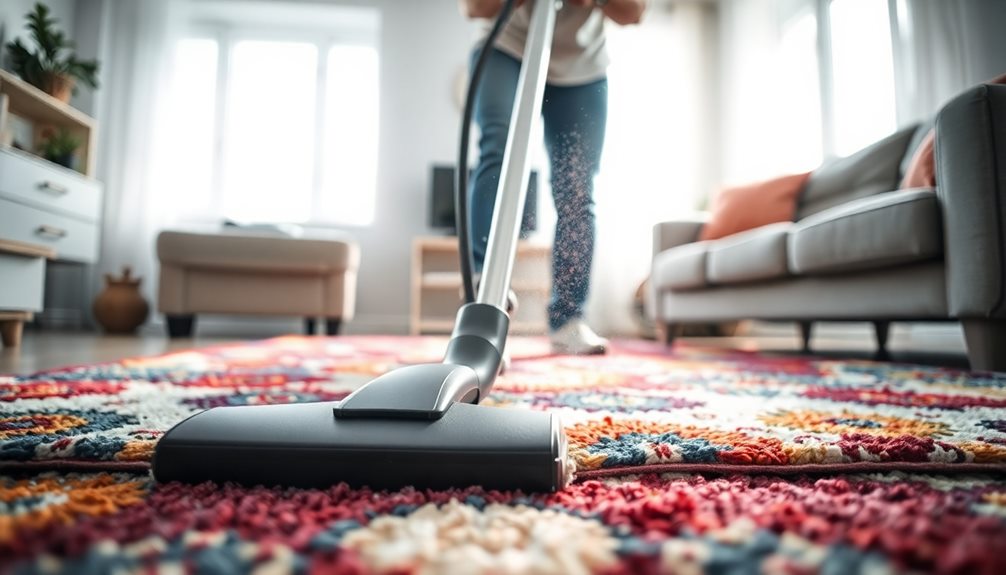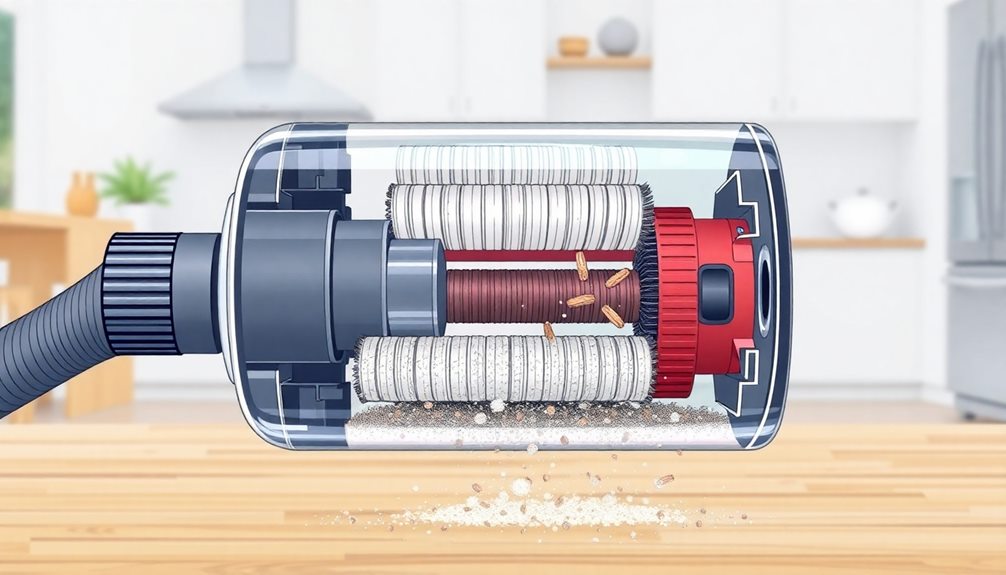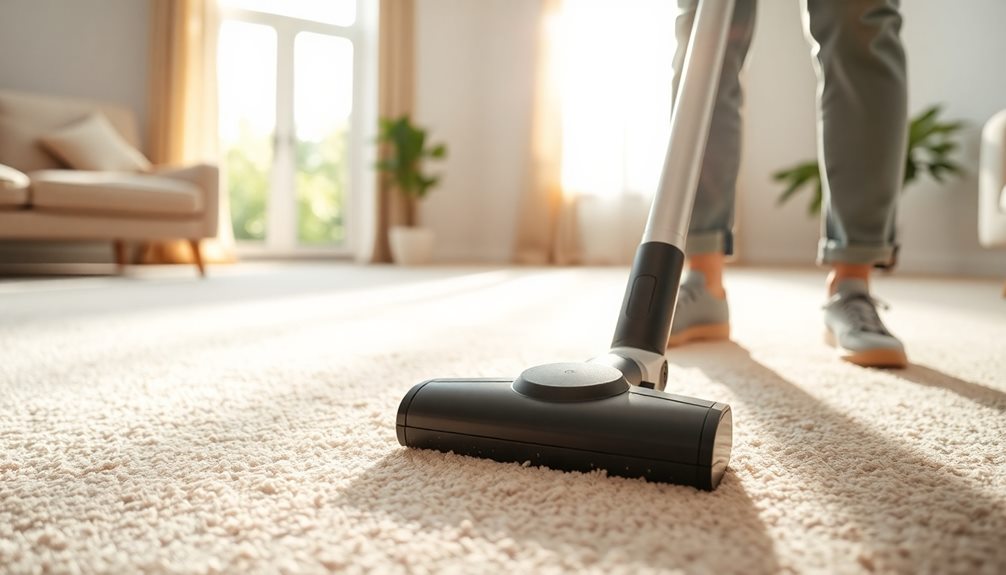To effectively use your vacuum cleaner at home, start by preparing it. Empty the dustbin or replace the bag, and check the filters for cleanliness. Next, adjust the vacuum height according to your flooring type. Slowly vacuum the entire area, focusing on high-traffic spots and using multiple directions to capture more dirt. Don't forget to pay attention to corners with a crevice tool. For best results, empty the dust container regularly and perform monthly inspections. If you want to keep your vacuum running smoothly and learn more tips, consider exploring additional techniques and maintenance practices.
Key Takeaways
- Prepare your vacuum by emptying the dustbin, checking filters, and inspecting for blockages before each use.
- Adjust the vacuum height setting based on your flooring type for optimal dirt removal.
- Vacuum slowly and in multiple directions to ensure thorough dirt pickup and maximum coverage.
- Focus on high-traffic areas and vacuum at least twice a week to manage dirt accumulation effectively.
- Regularly maintain your vacuum by cleaning the brush roll and inspecting components to ensure peak performance.
Preparing Your Vacuum Cleaner
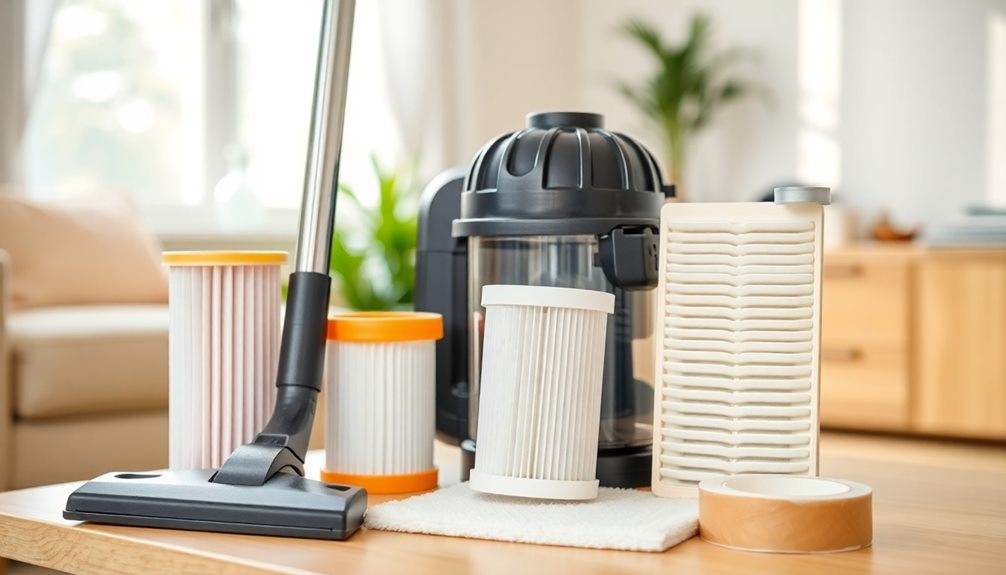
Before you start cleaning, make certain your vacuum cleaner is ready to go. First, empty the dustbin or replace the bag to guarantee peak suction and efficient dirt pickup. A full dustbin or bag can hinder your vacuum's performance, making it less effective.
Next, inspect the vacuum's filter; if it's dirty, clean or replace it to maintain proper airflow and cleaning power.
Don't forget about brush roll maintenance. Remove any tangled hair or debris to prevent blockages that could reduce your vacuum's effectiveness.
Also, adjust the vacuum height according to the type of flooring you're cleaning; this guarantees better contact and dirt removal from various surfaces.
Before diving into your cleaning session, conduct a quick inspection of all vacuum components. Check hoses, vacuum attachments, and other parts to confirm they're in good working order and free from obstructions.
This step is essential for maximizing your vacuum's performance. By taking these steps, you'll set yourself up for a successful cleaning experience, allowing your vacuum to deliver the best results possible.
Proper Vacuuming Techniques
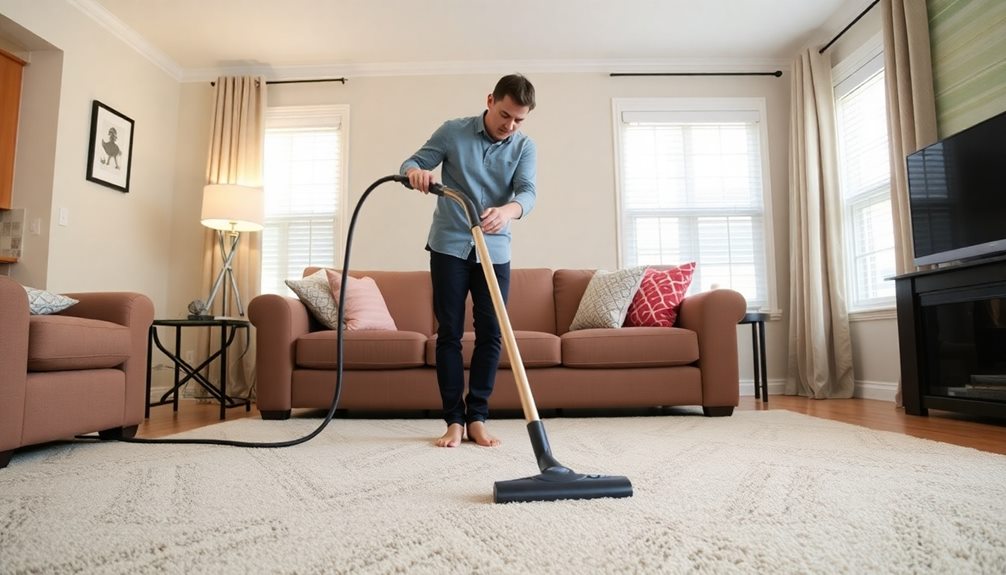
Effective vacuuming techniques are essential for achieving a clean and dust-free environment. Start by adjusting the settings on your vacuum cleaner according to the flooring type; lower it for carpets and raise it for hardwood or tile. This simple adjustment boosts cleaning efficiency and protects your surfaces.
When vacuuming, take your time—vacuuming slowly allows for thorough dirt pickup. Overlap each pass by about 50% to guarantee maximum coverage.
Don't forget to tackle high-traffic areas at least twice a week. This regular maintenance prevents dirt buildup and promotes better indoor air quality. Use multiple directions—up and down, as well as side to side—to capture more dust and debris effectively from your carpets and rugs.
Pay special attention to corners and edges, utilizing a crevice tool for tight spaces to remove dirt that regular vacuuming might miss.
Types of Vacuum Cleaners

When it comes to choosing the right vacuum cleaner, understanding the different types available can make all the difference in your cleaning routine.
If you have large carpeted areas, upright vacuums are ideal due to their powerful suction and adjustable height settings.
For versatility, canister vacuums excel with their hoses and wands that easily reach tight spots, making them perfect for stairs and under furniture.
If you need something compact for quick clean-ups, handheld vacuums are your best bet. They're designed for small messes, like crumbs or dirt in your car's interior.
For a more automated solution, robot vacuum cleaners can be programmed for daily maintenance, especially on hardwood floors and low-pile carpets, saving you time and effort.
Lastly, if mobility is what you seek, cordless vacuums are a great choice. They typically last between 20 to 40 minutes on a charge, making them convenient for quick clean-ups in smaller homes.
Each type has unique advantages, so consider your cleaning needs to find the perfect vacuum cleaner for you!
Vacuuming Frequency Guidelines

To keep your home clean and comfortable, you need to adjust your vacuuming frequency based on traffic levels in different areas.
High-traffic spots like hallways and living rooms require more attention, while low-traffic areas can be managed with less frequent cleaning.
Additionally, be mindful of seasonal needs or special occasions that may call for a boost in your vacuuming routine.
High-Traffic Area Frequency
High-traffic areas—like doorways, living rooms, and hallways—demand a vacuuming schedule that keeps dirt and dust at bay. To effectively maintain these spaces, aim to vacuum at least twice a week.
If you have pets or children, consider increasing the frequency to three times a week to manage messes and minimize the accumulation of dirt and dust.
Adjust your vacuuming schedule based on the amount of foot traffic these areas experience. Spot-cleaning should also be part of your routine; addressing spills and messes immediately helps maintain overall cleanliness.
Using your vacuum cleaner correctly during these sessions is essential for peak results.
Establishing a consistent cleaning routine in high-traffic zones not only keeps your home looking tidy but also improves indoor air quality and reduces allergens.
The frequency to vacuum in these areas plays a significant role in creating a healthier living environment. By staying on top of your vacuuming schedule, you'll guarantee that your home remains welcoming and free of unwanted debris.
Low-Traffic Area Frequency
Low-traffic areas, like guest rooms and home offices, require a different vacuuming approach to keep them clean and inviting. You typically only need to vacuum these spaces once a week. This frequency helps maintain home cleanliness without putting excessive wear on your vacuum cleaner.
However, it's important to monitor for dust accumulation, as even these less-used areas can attract allergens and dust mites over time. Investing in a vacuum with high suction power can enhance your cleaning effectiveness in these areas.
Incorporating regular vacuuming into your cleaning routine is vital for reducing the buildup of these irritants. Establishing a consistent weekly schedule for your low-traffic areas not only enhances cleanliness but also creates a more comfortable environment for guests.
While weekly vacuuming is generally sufficient, you might consider adjusting your vacuuming frequency during seasonal changes. For instance, spring and fall can bring about increased dust levels, making it a good time to be more vigilant.
Seasonal Cleaning Adjustments
Adjusting your vacuuming routine seasonally can make a significant difference in maintaining a clean and healthy home. During holiday seasons or family gatherings, increase your vacuum frequency in high-traffic areas to manage the extra dirt and debris that comes with more foot traffic.
If you have pets, especially during shedding seasons, aim to vacuum at least three times a week to control pet hair and allergens effectively.
Spring and fall are ideal times for deep cleaning, so make sure to include vacuuming in all areas of your home, even those less frequently used spaces like guest rooms and attics.
Regional factors also play a role; for instance, if you live in a dusty or rural area, you may need to vacuum more often compared to urban homes.
Pay attention to seasonal changes, too. In spring, when pollen levels rise, increase your vacuuming to help improve indoor air quality and reduce allergens.
Common Mistakes to Avoid
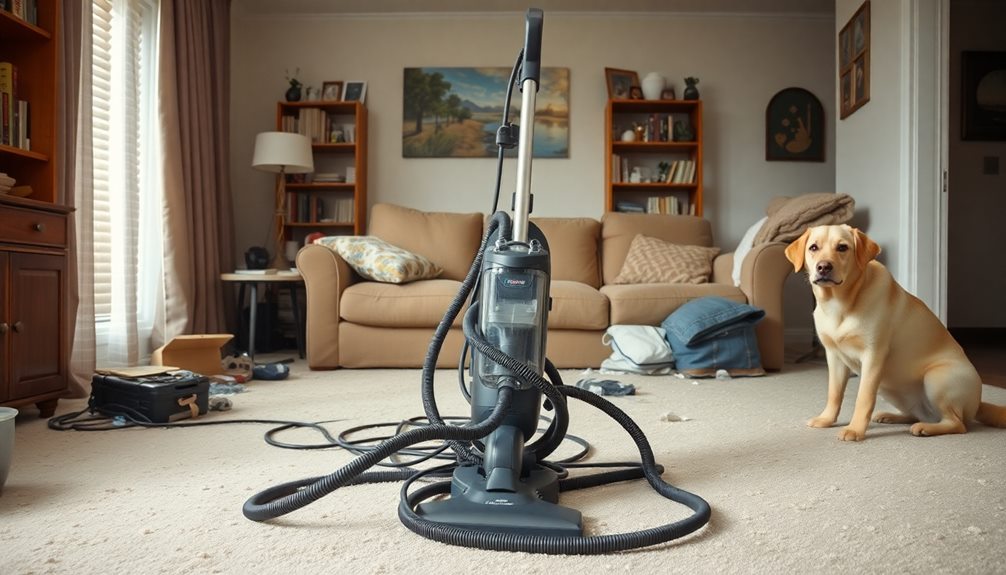
When using your vacuum cleaner, it's easy to overlook a couple of common mistakes that can hinder its performance.
For instance, don't let the dustbin or bag get too full, and make sure you regularly clean or replace the filter.
These simple steps can make a big difference in maintaining your vacuum's efficiency.
Overfilling Dust Containers
Overfilling your vacuum's dust container is a common mistake that can seriously affect its performance. When you neglect to empty the dustbin regularly, it can quickly become overfilled, leading to reduced suction power.
Vacuums operate best when the dust container is no more than two-thirds full, guaranteeing peak airflow for efficient cleaning. A full dustbin forces your vacuum to work harder, which may result in overheating and potential motor damage over time.
To maintain performance, it's essential to empty the dust container after each use. By doing this, you not only keep suction strong but also minimize the chance of having to deal with frequent vacuuming sessions due to ineffective dirt and debris pickup.
Many advanced vacuum models come equipped with indicator lights that alert you when the dustbin is full, helping you avoid overfilling. Make it a habit to check the dust container before you start cleaning, and don't ignore those warning lights.
Keeping your vacuum's dust container properly managed will guarantee you enjoy consistent efficiency and prolong the life of your machine.
Ignoring Filter Maintenance
Ignoring filter maintenance can severely affect your vacuum's performance. When you neglect to clean or replace your vacuum's filter, clogged filters can reduce suction power by up to 50%, making your cleaning efforts less effective.
Most manufacturers recommend checking and cleaning filters at least once a month to guarantee ideal performance and maintain good indoor air quality.
A clean filter not only enhances suction but also prolongs your vacuum's lifespan. When filters become dirty, they restrict airflow, forcing the motor to work harder, which can lead to overheating and potential failure.
If you've invested in a vacuum with a HEPA filter, it's particularly important to keep it clean, as these filters capture 99.97% of particles that are 0.3 microns or larger, greatly improving air quality, especially in homes with allergy sufferers.
Don't underestimate the importance of regular filter maintenance. By taking a few minutes to check and clean your vacuum's filter, you can maintain strong suction power, improve indoor air quality, and extend the life of your appliance.
Maintaining Your Vacuum Cleaner
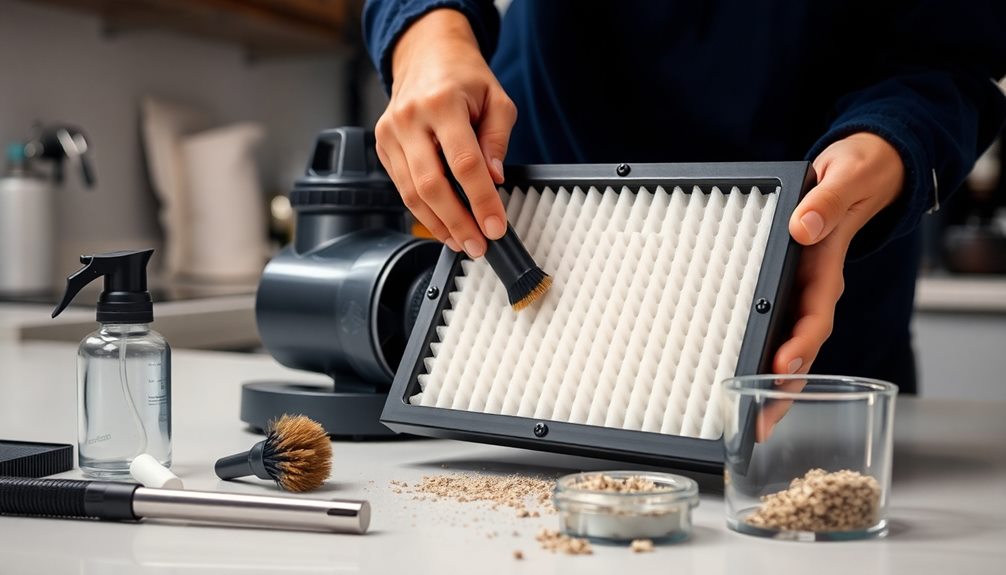
Maintaining your vacuum cleaner is essential for keeping it running efficiently and prolonging its life. Start by regularly emptying the dustbin or changing the bag when it's 50-75% full. This helps maintain peak suction and prevents motor strain.
Don't forget to replace filters according to the manufacturer's recommendations, usually every 1-3 months, to guarantee proper airflow and efficiency.
After each use, take a moment to clean the brush roll, removing any hair or debris buildup. This simple step can greatly improve your vacuum's cleaning performance.
Additionally, check for blockages in the hose and attachments monthly. Clearing any obstructions will prevent loss of suction and assure thorough cleaning.
Lastly, how you store your vacuum matters too. Keep it in a cool, dry place, and avoid leaving it plugged in to extend its lifespan and maintain safety.
Frequently Asked Questions
How Do You Use a Vacuum Cleaner Step by Step?
To use a vacuum cleaner step by step, start by preparing it. Then adjust settings, vacuum from the farthest corner, overlap passes, focus on edges, and finish by emptying the dust bin or replacing the bag.
How to Use a Vacuum Properly?
To use a vacuum properly, you've gotta check the dust bag, adjust the height for your floor type, vacuum slowly, overlap your passes, and don't forget those corners. Always empty it afterward for peak performance!
How to Use Vacuum Cleaner on Floor?
Did you know that over 80% of household dust comes from human skin? To effectively vacuum your floors, adjust the height setting, start from the corner, and use overlapping strokes for thorough cleaning.
How to Use Vacuum Cleaner for Carpet?
When tackling carpet cleaning, adjust your vacuum's height setting for effective brush engagement. Vacuum slowly in straight lines, switch to carpet mode, and use the crevice tool for corners. Regularly check the brush roll for peak performance.
Conclusion
By following these tips, you can transform your vacuuming routine from a chore into a breeze. Think of your vacuum cleaner as a trusty sidekick, ready to tackle dirt and dust alongside you. With the right techniques and maintenance, you'll not only keep your home spotless but also extend the life of your appliance. So, roll up your sleeves, wield your vacuum with confidence, and watch as your living space shines like never before!
